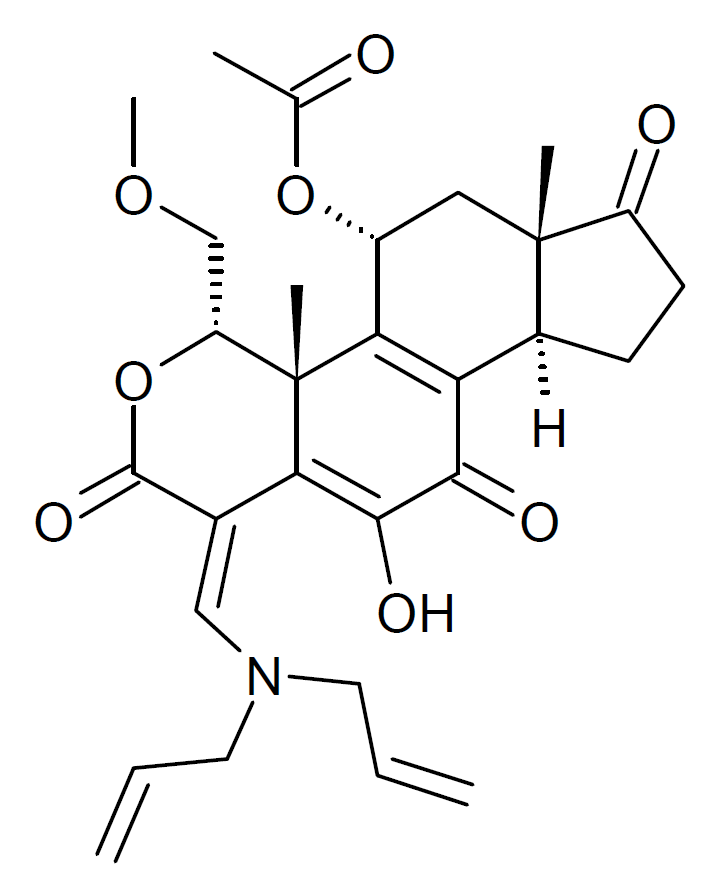|
P110α
The phosphatidylinositol-4,5-bisphosphate 3-kinase, catalytic subunit alpha (the HUGO-approved official symbol = PIK3CA; HGNC ID, HGNC:8975), also called p110α protein, is a class I PI 3-kinase catalytic subunit. The human p110α protein is encoded by the ''PIK3CA'' gene. Its role was uncovered by molecular pathological epidemiology (MPE). Function Phosphatidylinositol-4,5-bisphosphate 3-kinase (also called phosphatidylinositol 3-kinase (PI3K)) is composed of an 85 kDa regulatory subunit and a 110 kDa catalytic subunit. The protein encoded by this gene represents the catalytic subunit, which uses ATP to phosphorylate phosphatidylinositols (PtdIns), PtdIns4P and PtdIns(4,5)P2. The involvement of p110α in human cancer has been hypothesized since 1995. Support for this hypothesis came from genetic and functional studies, including the discovery of common activating PIK3CA missense mutations in common human tumors. It has been found to be oncogenic and is implicated in cerv ... [...More Info...] [...Related Items...] OR: [Wikipedia] [Google] [Baidu] |
|
|
Phosphoinositide 3-kinase
Phosphoinositide 3-kinases (PI3Ks), also called phosphatidylinositol 3-kinases, are a family of enzymes involved in cellular functions such as cell growth, proliferation, differentiation, motility, survival and intracellular trafficking, which in turn are involved in cancer. PI3Ks are a family of related intracellular signal transducer enzymes capable of phosphorylating the 3 position hydroxyl group of the inositol ring of phosphatidylinositol (PtdIns). The pathway, with oncogene PIK3CA and tumor suppressor gene PTEN, is implicated in the sensitivity of cancer tumors to insulin and IGF1, and in calorie restriction. Discovery The discovery of PI3Ks by Lewis Cantley and colleagues began with their identification of a previously unknown phosphoinositide kinase associated with the polyoma middle T protein. They observed unique substrate specificity and chromatographic properties of the products of the lipid kinase, leading to the discovery that this phosphoinositide kinase had ... [...More Info...] [...Related Items...] OR: [Wikipedia] [Google] [Baidu] |
|
|
Class I PI 3-kinase
Class I PI 3-kinases are a subgroup of the enzyme family, phosphoinositide 3-kinase that possess a common protein domain structure, substrate specificity, and method of activation. Class I PI 3-kinases are further divided into two subclasses, class IA PI 3-kinases and class IB PI 3-kinases. Class IA PI 3-kinases Class IA PI 3-kinases are activated by receptor tyrosine kinases (RTKs). There are three catalytic subunits that are classified as class IA PI 3-kinases: * p110α *p110β * p110δ There are currently five regulatory subunits that are known to associate with class IA PI 3-kinases catalytic subunits: *p85α and p85β * p55α and p55γ *p50α Class IB PI 3-kinases Class IB PI 3-kinases are activated by G-protein-coupled receptors (GPCRs). The only known class IB PI 3-kinase catalytic subunit is p110γ. There are two known regulatory subunits for p110γ: * p101 *p84/ p87PIKAP. See also * Phosphoinositide 3-kinase#Class I * Phosphoinositide 3-kinase inhibitor Phospho ... [...More Info...] [...Related Items...] OR: [Wikipedia] [Google] [Baidu] |
|
|
PIK3CA-related Overgrowth Spectrum
PIK3CA-related overgrowth spectrum (PROS) is an umbrella term for rare syndromes characterized by malformations and tissue overgrowth caused by somatic mutations in PIK3CA gene. In PROS diseases individuals malformations are seen in several different tissues such as skin, vasculature, bones, fat and brain tissue depending on the specific disease. __TOC__ PROS spectrum diseases PROS spectrum diseases include: * Fibro-adipose vascular anomaly * Hemihyperplasia–multiple lipomatosis syndrome * CLOVES syndrome * Macrodactyly * Facial infiltrating lipomatosis * Macrocephaly-capillary malformation * Dysplastic megalencephaly * Klippel–Trénaunay syndrome Pathophysiology PIK3CA gene codes for p110α protein which is a catalytic subunit of phosphoinositide 3-kinase Phosphoinositide 3-kinases (PI3Ks), also called phosphatidylinositol 3-kinases, are a family of enzymes involved in cellular functions such as cell growth, proliferation, differentiation, motility, survival and intr ... [...More Info...] [...Related Items...] OR: [Wikipedia] [Google] [Baidu] |
|
|
Human Genome Organisation
The Human Genome Organisation (HUGO) is a non-profit organization founded in 1988. HUGO represents an international coordinating scientific body in response to initiatives such as the Human Genome Project. HUGO has four active committees, including the HUGO Gene Nomenclature Committee (HGNC), and the HUGO Committee on Ethics, Law and Society (CELS). History HUGO was established at the first meeting on genome mapping and sequencing at Cold Spring Harbor in 1988. The idea of starting the organization stemmed from South African biologist Sydney Brenner, who is best known for his significant contributions to work on the genetic code and other areas of molecular biology, as well as winning the 2002 Nobel Prize in Physiology or Medicine The Nobel Prize in Physiology or Medicine ( sv, Nobelpriset i fysiologi eller medicin) is awarded yearly by the Nobel Assembly at the Karolinska Institute, Nobel Assembly at the Karolinska Institute for outstanding discoveries in physiology or .... ... [...More Info...] [...Related Items...] OR: [Wikipedia] [Google] [Baidu] |
|
|
Phosphoinositide 3-kinase Inhibitor
Phosphoinositide 3-kinase inhibitors (PI3K inhibitors) are a class of medical drugs that are mainly used to treat advanced cancers. They function by inhibiting one or more of the phosphoinositide 3-kinase (PI3K) enzymes, which are part of the PI3K/AKT/mTOR pathway. This signal pathway regulates cellular functions such as growth and survival. It is strictly regulated in healthy cells, but is always active in many cancer cells, allowing the cancer cells to better survive and multiply. PI3K inhibitors block the PI3K/AKT/mTOR pathway and thus slow down cancer growth. They are examples of a targeted therapy. While PI3K inhibitors are an effective treatment, they can have very severe side effects and are therefore only used if other treatments have failed or are not suitable. After PI3K inhibitors had been under investigation as anti-cancer drugs for several years, the first one to be approved for treatment in clinical practice was idelalisib in 2014. Several others followed, and even m ... [...More Info...] [...Related Items...] OR: [Wikipedia] [Google] [Baidu] |
|
 |
Follicular Lymphoma
Follicular lymphoma (FL) is a cancer that involves certain types of white blood cells known as lymphocytes. The cancer originates from the uncontrolled division of specific types of B-cells known as centrocytes and centroblasts. These cells normally occupy the follicles (nodular swirls of various types of lymphocytes) in the germinal centers of lymphoid tissues such as lymph nodes. The cancerous cells in FL typically form follicular or follicle-like structures (see adjacent Figure) in the tissues they invade. These structures are usually the dominant histological feature of this cancer. There are several synonymous and obsolete terms for FL such as CB/CC lymphoma (centroblastic and centrocytic lymphoma), nodular lymphoma, Brill-Symmers Disease, and the subtype designation, follicular large-cell lymphoma. In the US and Europe, this disease is the second most common form of non-Hodgkin's lymphomas, exceeded only by diffuse large B-cell lymphoma. FL accounts for 10-20% of non-Ho ... [...More Info...] [...Related Items...] OR: [Wikipedia] [Google] [Baidu] |
.jpg) |
Food And Drug Administration
The United States Food and Drug Administration (FDA or US FDA) is a federal agency of the Department of Health and Human Services. The FDA is responsible for protecting and promoting public health through the control and supervision of food safety, tobacco products, caffeine products, dietary supplements, prescription and over-the-counter pharmaceutical drugs (medications), vaccines, biopharmaceuticals, blood transfusions, medical devices, electromagnetic radiation emitting devices (ERED), cosmetics, animal foods & feed and veterinary products. The FDA's primary focus is enforcement of the Federal Food, Drug, and Cosmetic Act (FD&C), but the agency also enforces other laws, notably Section 361 of the Public Health Service Act, as well as associated regulations. Much of this regulatory-enforcement work is not directly related to food or drugs, but involves such things as regulating lasers, cellular phones, and condoms, as well as control of disease in contexts v ... [...More Info...] [...Related Items...] OR: [Wikipedia] [Google] [Baidu] |
|
Copanlisib
Copanlisib (trade name Aliqopa ; codenamed BAY 80-6946) is a drug which is approved by US FDA for the treatment of adult patients experiencing relapsed follicular lymphoma who have received at least two prior systemic therapies. Copanlisib has been shown to have an effect against survival and spread of cancerous B-cells. Efficacy resulting in the approval of copanlisib was based on the subgroup of 104 patients with follicular lymphoma from a Phase 2 clinical trial. Of these, 59 percent had a complete or partial shrinkage of their tumors that lasted about 12 months. To assess the safety of the drug, data from 168 adults with follicular lymphoma and other hematologic malignancies treated with copanlisib were evaluated. Copanlisib is administered as intravenous infusion on a weekly but intermittent schedule (three weeks on and one week off). Copanlisib is currently approved only in the United States. Adverse effects Data for safety and efficacy of copanlisib are described in the ... [...More Info...] [...Related Items...] OR: [Wikipedia] [Google] [Baidu] |
|
|
LY294002
LY294002 is a morpholine-containing chemical compound that is a potent inhibitor of numerous proteins, and a strong inhibitor of phosphoinositide 3-kinases (PI3Ks). It is generally considered a non-selective research tool, and should not be used for experiments aiming to target PI3K uniquely. Two of these are the proto-oncogene serine/threonine-protein kinase ( PIM1) and the phosphatidylinositol-4,5-bisphosphate 3-kinase P110 gamma, catalytic subunit gamma isoform. With an IC50 of 1.4 μM it is somewhat less potent than wortmannin, another well-known PI3 kinase inhibitor. However, LY294002 is a reversible inhibitor of PI3K whereas wortmannin acts irreversibly. Application of LY294002 causes a substantial acceleration of MEPP End plate potentials (EPPs) are the voltages which cause depolarization of skeletal muscle fibers caused by neurotransmitters binding to the postsynaptic membrane in the neuromuscular junction. They are called "end plates" because the postsynapti ... fr ... [...More Info...] [...Related Items...] OR: [Wikipedia] [Google] [Baidu] |
|
 |
Wortmannin
Wortmannin, a steroid metabolite of the fungi '' Penicillium funiculosum'', ''Talaromyces wortmannii'', is a non-specific, covalent inhibitor of phosphoinositide 3-kinases (PI3Ks). It has an ''in vitro'' inhibitory concentration (''IC''50) of around 5 nM, making it a more potent inhibitor than LY294002, another commonly used PI3K inhibitor. It displays a similar potency ''in vitro'' for the class I, II, and III PI3K members although it can also inhibit other PI3K-related enzymes such as mTOR, DNA-PKcs, some phosphatidylinositol 4-kinases, myosin light chain kinase (MLCK) and mitogen-activated protein kinase (MAPK) at high concentrations Wortmannin has also been reported to inhibit members of the polo-like kinase family with ''IC''50 in the same range as for PI3K. The half-life of wortmannin in tissue culture is about 10 minutes due to the presence of the highly reactive C20 carbon that is also responsible for its ability to covalently inactivate PI3K. Wortmannin is a ... [...More Info...] [...Related Items...] OR: [Wikipedia] [Google] [Baidu] |
 |
Hyperplasia
Hyperplasia (from ancient Greek ὑπέρ ''huper'' 'over' + πλάσις ''plasis'' 'formation'), or hypergenesis, is an enlargement of an organ or tissue caused by an increase in the amount of organic tissue that results from cell proliferation. It may lead to the gross enlargement of an organ, and the term is sometimes confused with benign neoplasia or benign tumor. Hyperplasia is a common preneoplastic response to stimulus. Microscopically, cells resemble normal cells but are increased in numbers. Sometimes cells may also be increased in size (hypertrophy). Hyperplasia is different from hypertrophy in that the adaptive cell change in hypertrophy is an increase in the ''size'' of cells, whereas hyperplasia involves an increase in the ''number'' of cells. Causes Hyperplasia may be due to any number of causes, including proliferation of basal layer of epidermis to compensate skin loss, chronic inflammatory response, hormonal dysfunctions, or compensation for damage ... [...More Info...] [...Related Items...] OR: [Wikipedia] [Google] [Baidu] |